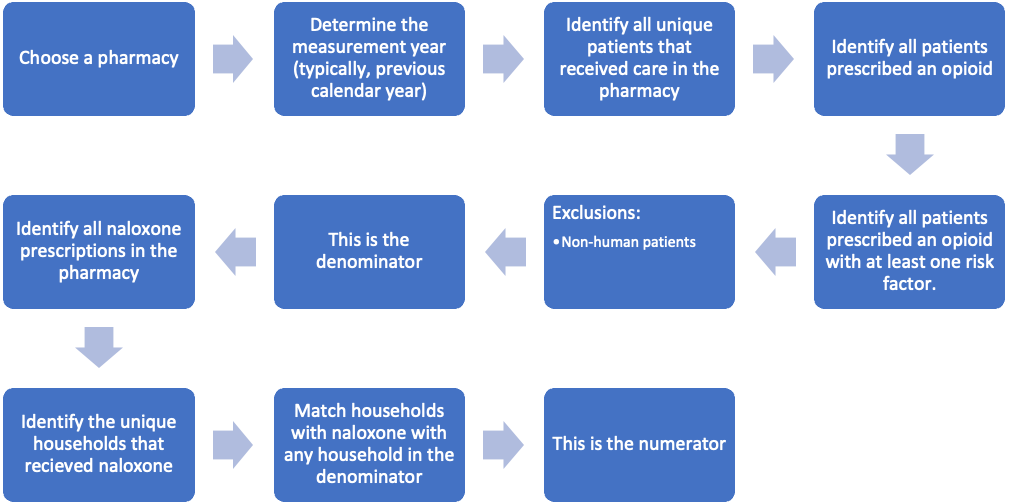Improving Pain Management Safety
|
Title |
Improving Pain Management Safety |
|
Description |
Percent of households where at least one individual is at risk for adverse opioid event, like overdose or respiratory depression, with naloxone available.
A higher score is better |
|
Rationale |
Many individuals are at increased risk for adverse events associated with opioid use. Additionally, many states have implemented standing protocols for naloxone dispensing without prescription to patients or caregivers of patients at risk for adverse opioid events. This measure ensures, at a household level, naloxone is available to any patient. |
|
Logic Model |
This measure ensures any household at risk for adverse opioid events is evaluated and provided treatment. |
|
Level of Analysis |
Pharmacy (Patient) |
|
Data Source |
Pharmacy Data |
|
Denominator Statement |
Any household with a patient at risk for adverse opioid event defined as patients prescribed opioids and any of the following:
|
|
Denominator Calculation |
1. 1. All individuals in the pharmacy 2. 2. All individuals prescribed an opioid 3. 3. All individuals with risk factor (≥50 MME or benzodiazepine) 4. 4. Exclude non-human patients 5. 5. Identify each unique household |
|
Denominator Exclusions |
Any non-human patients (e.g., cats, dogs, clinics, office-use, etc) |
|
Denominator Exclusion Rationale |
Pharmacies may provide care to pets or other veterinarian needs, or for office-use. This patient profiles should be excluded from the measure calculation. |
|
Numerator Statement |
Household from the denominator with a naloxone dispensed during the measurement year |
|
Numerator Calculation |
1. 1. Identify all naloxone prescriptions dispensed from the pharmacy 2. 2. Identify each household with a naloxone prescription 3. 3. Households that have a match in the denominator are in the numerator. |
|
Seguridad Measure Specification Process |
|
|
Data Stratification |
The measure rate will be reported as a percent of patients within a single pharmacy.
If available and feasible, measure rate will be reported by type of pharmacy (e.g., health-system, community, specialty, mail-order, long-term care).
If available and feasible, measure rate will be reported by line of business (pharmacy Medicare rate, pharmacy Medicaid rate, pharmacy Commercial rate, and pharmacy uninsured rate).
Risk adjustment will be applied when available. |
|
Value Sets |
The value set Seguridad – Opioids and Seguridad – Opioid Risk Medications will be used to support the exclusion criteria. |
|
Future Iterations |
Many pharmacy measures are designed as structure or process. Future goals of this concept include measures focused on appropriate dosing based on renal function and assessment of all patients. |
|
Harmonization1 |
Payors: PQA’s Opioid Measure Set Providers: PQA’s Opioid Measure Set |
1. Measures that have either the same target populations (denominator) or the same measure focus (numerators) may be considered related, whereas measures that have the same targeted population (denominator) and same measure focus (numerator), are considered competing measures. Measures being developed should be harmonized, where feasible, to previously established measures to decrease measure burden. Choose My Pharmacy measures are developed for pharmacy evaluation, which is a novel area for measurement science, no current measure evaluates this level of analysis. Choose My Pharmacy measures will be harmonized to the extent possible, recognizing different levels of analysis have different data elements, and instead the focus will be to vertically integrate the Choose My Pharmacy measures with other measurement systems and measures.


No Comments